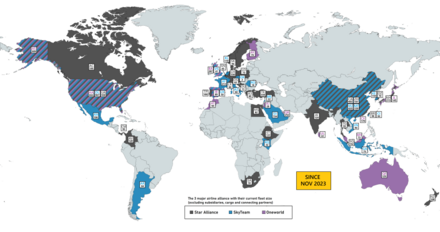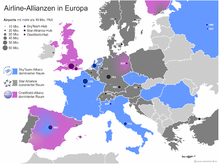Aviation Alliance
An aviation alliance is a strategic cooperation between several aviation companies ( airlines ). The companies remain legally independent.
The forerunners of all today's aviation alliances were the two consortia ATLAS and KSSU , which several European airlines joined at the end of the 1960s. These consortia initially served to keep the operating, maintenance and training costs for the commissioning of the then new wide-body aircraft as low as possible. In the years that followed, the cooperation resulted in standardized maintenance procedures and uniform training programs for pilots and technical staff. In addition, the two consortia set a number of standards for aircraft components (e.g. for galleys ) and split the maintenance work on their aircraft among themselves. Both consortia lasted until the mid-1990s.
Today's alliances focus less on technical cooperation and more on flight operations. For this purpose, the companies coordinated their flight schedules and used elements such as common frequent flyer programs , standardized booking systems and mutual leasing of seats in their aircraft (see codeshare ).
Alliances between airlines are now mainly formed because aviation law is organized nationally. Only domestic airlines that are authorized by bilateral agreements are allowed to fly within a country; a bilateral agreement is always required between two countries. Due to the national structure of these agreements, a cross-border merger of airlines would lose part of their landing rights. Despite the lower potential for savings, alliances are therefore usually preferred.
rating
Aviation alliances allow costs to be reduced through codeshare , through shared facilities (sales offices, maintenance, catering , computer systems), shared staff , advantages in purchasing (wholesale discounts, savings in administrative expenses) and cost reductions in the frequent flyer program. By joining an alliance, the individual airlines can offer a greater selection of flight segments and connection options.
Ideally, this results in coordinated travel times and optimized offers for consumers.
Lineup
International alliances (passenger)

Valid from May 1st, 2020
The following table contains the most important international aviation alliances:
| alliance | Founded | Members | Planes | Employee | Passenger volume | Sales (in $ ) | Destinations | Daily flights |
|---|---|---|---|---|---|---|---|---|
| Star Alliance | 1997 | 27 | 4,338 | 439.232 | 637.62 million | 173.12 billion | 1269 | 18,043 |
| SkyTeam | 2000 | 20th | 4,467 | 459.781 | 588 million | 137 billion (2009) | 1064 | 15,723 |
| Oneworld | 1999 | 15th | 3,303 | 385,609 | 496 million | 141 billion | 982 | 13,976 |
| continent | Oneworld | SkyTeam | Star Alliance |
|---|---|---|---|
| North America | |||
| South America | - | ||
| Europe | |||
| Asia | |||
| Africa | |||
| Oceania |
|
- | |
|
A Founding members |
|||
Regional alliances (passenger)
In 2015, the airlines of the states in the Indian Ocean founded the Alliance Vanille (see the term Vanilla Islands for these states). In 2016, two alliances were founded that consist only of low-cost airlines , namely the U-FLY Alliance with a focus on East and Southeast Asia and the Value Alliance with members in the West Pacific.
Another major aviation alliance was the Qualiflyer Group around the former Swiss airline Swissair . It was dissolved in 2001. The AiRUnion (five Russian airlines) was also dissolved in 2008.
The largest national alliance was the Xinxing Alliance in the People's Republic of China . Six Chinese airlines, including Hainan Airlines and Sichuan Airlines , worked together briefly in this alliance.
International Alliances (Cargo)
The merger of two cargo airlines appears on the market as a WOW .
Individual evidence
- ^ Member airline . Star Alliance . March 31, 2014. Archived from the original on March 4, 2013. Retrieved on April 8, 2014.
- ↑ Facts and Figures . SkyTeam . March 5, 2014. Retrieved April 8, 2014.
- ↑ Oneworld at a glance . Oneworld . March 31, 2014. Retrieved April 8, 2014.
